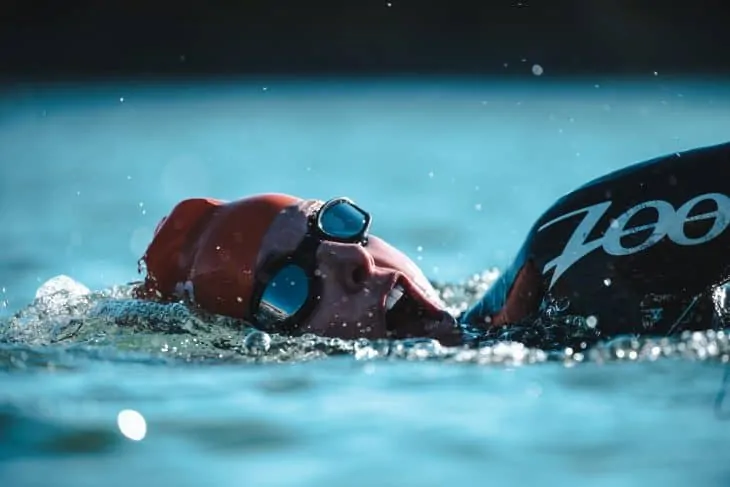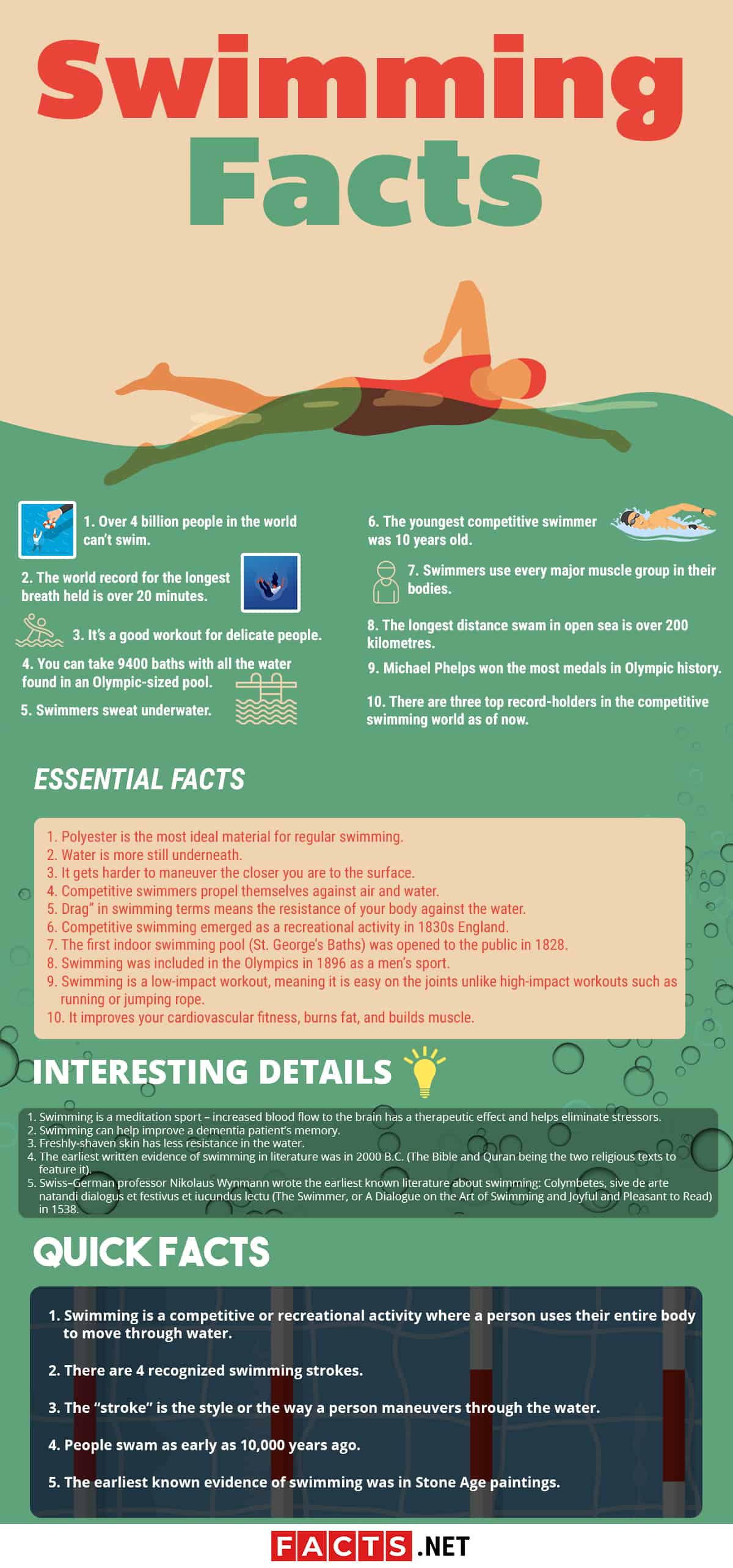
While some people want to fly, others find freedom within the waters. These swimming facts go from the basics up to the intriguing – and somewhat strange. From the history of swimming, world records, to how our body works in the water. You’ll be in awe of these seemingly amphibian individuals.
- Swimming is a competitive or recreational activity where a person uses their entire body to move through water.
- There are 4 recognized swimming strokes.
- The “stroke” is the style or the way a person maneuvers through the water.
- People swam as early as 10,000 years ago.
- The earliest known evidence of swimming was in Stone Age paintings.
- Polyester is the most ideal material for regular swimming.
- Water is more still underneath.
- It gets harder to maneuver the closer you are to the surface.
- Competitive swimmers propel themselves against air and water.
- “Drag” in swimming terms means the resistance of your body against the water.
- Competitive swimming emerged as a recreational activity in 1830s England.
- The first indoor swimming pool (St. George’s Baths) was opened to the public in 1828.
- Swimming was included in the Olympics in 1896 as a men’s sport.
- Swimming is a low-impact workout, meaning it is easy on the joints unlike high-impact workouts such as running or jumping rope.
- It improves your cardiovascular fitness, burns fat, and builds muscle.
- Swimming is a meditation sport – increased blood flow to the brain has a therapeutic effect and helps eliminate stressors.
- Swimming can help improve a dementia patient’s memory.
- Freshly-shaven skin has less resistance in the water.
- The earliest written evidence of swimming in literature was in 2000 B.C. (The Bible and Quran being the two religious texts to feature it).
- Swiss–German professor Nikolaus Wynmann wrote the earliest known literature about swimming: Colymbetes, sive de arte natandi dialogus et festivus et iucundus lectu (The Swimmer, or A Dialogue on the Art of Swimming and Joyful and Pleasant to Read) in 1538.
Swimming Facts Infographics

Over 4 billion people in the world can’t swim.
More than half of the global population does not know how to swim, so you don’t need to feel too bad about yourself. However, it could be a handy life skill. Drowning is the 3rd leading cause of unintentional injury deaths worldwide.
The world record for the longest breath held is over 20 minutes.

Spanish freediver Aleix Segura Vendell can hold his breath for 24 minutes and 3 seconds. Freediving is an underwater diving method that forgoes a breathing apparatus. Instead of an oxygen tank, freedivers merely rely on the oxygen in their lungs. This guy definitely kills it at birthday parties.
It’s a good workout for delicate people.
Since swimming is a low-impact workout, it’s great for people in delicate conditions. This includes injuries, pregnancy, and other restrictions such as age or physical limitations. In fact, water yoga and water jogging have only increased in popularity throughout the years for people with joint pain. It is also used for physical therapy or rehabilitation.
You can take 9400 baths with all the water found in an Olympic-sized pool.
Olympic sized pool volume is around 660,000 gallons of water. An Olympic-size swimming pool is approximately 164 feet long, 82 feet wide, and 6 feet deep. The average bathtub can only contain 70 gallons of water. It’s only fitting, because…
...Swimmers sweat underwater.
It’s a question we’ve all asked ourselves. Why don’t fish drown? Do fish pee? Similarly, do swimmers sweat? Yes, in fact, they do. Sweating is the biological function of the body to cool itself. During intense workouts, the body will perspire even in the water. However, it’s barely noticeable even to the swimmers themselves since the water washes the sweat off.
The youngest competitive swimmer was 10 years old.
Alzain Tareq of Bahrain became the world’s youngest competitive swimmer to ever debut in a world championship. She competed against swimmers twice her age for the 50m butterfly, which she finished in 41.13 seconds.
Surprisingly, children can learn how to swim as early as two months of age. A majority of drowning casualties are children, so teaching them how to swim will reduce this risk. In fact, drowning risks reduced by 88% in 2009 when children between the ages of 1-4 participated in swimming lessons in the U.S.
Swimmers use every major muscle group in their bodies.
Swimming is a total body workout that engages all the major muscles in the body such as the chest, back, arm, foot, and leg muscles.
More specifically:
The latissimus dorsi muscle or “lats” are the muscles in your middle back. Push your hands together in front of the lower part of your chest, and you’ll flex your latissimus dorsi muscles. Lats are vital to your ability to pull and swivel through the water to take breaths.
Tricep muscles are the muscles behind your upper arm. These muscles give your pull the final push and allow you to complete a stroke to your hips. This lets you maximize your stroke at the best speed.
The pectoral muscles or chest muscles are more commonly known as “pecs.” Your chest muscles are the deciding factor for the freestyle stroke and breaststroke. These muscles stabilize your movements for a more efficient and long-lasting stroke.
The core muscles or abs also stabilize your body and keeps you buoyant.
Your “quads” or quadricep muscles give your motions an extra kick – literally. The muscles in front of your thighs are vital during starts and turns and help you propel yourself further and faster.
The longest distance swam in open sea is over 200 kilometres.
Veljko Rogošić of Croatia swam 225 km (139.8 miles) without flippers. He traveled from Grado to Riccione across the Adriatic Sea from 29-31 August 2006. Overall, the journey took him 50 hours and 10 mins. Talk about dedication.
Michael Phelps won the most medals in Olympic history.
American swimmer Michael Phelps has won 23 gold, 3 silvers, and 2 bronze Olympic medals along with 13 individual golds in his day. He was notorious for the 100m butterfly. At the end of the 2008 Olympics, Phelps had 7 world records and 1 Olympic record. All in all, Phelps set a whopping 39 world records – the most of all time. With all this glory, he retired after the 2016 Olympics.
There are three top record-holders in the competitive swimming world as of now.
Caeleb Dressel of the U.S. wowed the competitive swimming world when he beat Michael Phelps’ 100m butterfly record by 0.32 seconds. This guy currently holds 7 records, the most in the men’s category.
For women’s competitive swimming, Sarah Sjöström of Sweden and Katinka Hosszú of Hungary tie for the most records held at 6 records each. Sjöström is the current world record holder for the 50-meter freestyle, 100-meter freestyle, 200-meter freestyle, 50-meter butterfly, and the 100-meter butterfly. Hosszú, on the other hand, was the first woman to win four consecutive world titles in a single event.
Was this page helpful?
Our commitment to delivering trustworthy and engaging content is at the heart of what we do. Each fact on our site is contributed by real users like you, bringing a wealth of diverse insights and information. To ensure the highest standards of accuracy and reliability, our dedicated editors meticulously review each submission. This process guarantees that the facts we share are not only fascinating but also credible. Trust in our commitment to quality and authenticity as you explore and learn with us.
